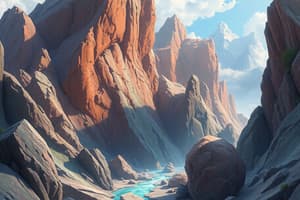Podcast
Questions and Answers
Which geological formation is characterized by its ability to store and transmit significant quantities of groundwater?
Which geological formation is characterized by its ability to store and transmit significant quantities of groundwater?
- Aquitard
- Aquiclude
- Aquifer (correct)
- Aquitard
What boundary separates the saturated and unsaturated zones in the subsurface?
What boundary separates the saturated and unsaturated zones in the subsurface?
- Confining layer
- Aquiclude
- Capillary fringe
- Water table (correct)
According to Darcy's Law, what primarily drives the flow of groundwater through porous media?
According to Darcy's Law, what primarily drives the flow of groundwater through porous media?
- Chemical diffusion
- Temperature gradient
- Hydraulic gradient (correct)
- Electrical potential
Which of the following geological scenarios would typically result in a confined aquifer?
Which of the following geological scenarios would typically result in a confined aquifer?
What term describes the process by which water infiltrates the ground and replenishes an aquifer?
What term describes the process by which water infiltrates the ground and replenishes an aquifer?
Which factor is LEAST likely to influence the chemical composition of groundwater?
Which factor is LEAST likely to influence the chemical composition of groundwater?
Which of the following is a potential consequence of excessive groundwater pumping in coastal areas?
Which of the following is a potential consequence of excessive groundwater pumping in coastal areas?
What is the primary purpose of conducting geophysical surveys, such as seismic refraction and electrical resistivity, in hydrogeological investigations?
What is the primary purpose of conducting geophysical surveys, such as seismic refraction and electrical resistivity, in hydrogeological investigations?
In the context of hydrogeology, what does 'hydraulic head' represent?
In the context of hydrogeology, what does 'hydraulic head' represent?
Which type of geological formation would be MOST suitable for the construction of a large-scale groundwater reservoir?
Which type of geological formation would be MOST suitable for the construction of a large-scale groundwater reservoir?
Which of the following describes the relationship between groundwater and surface water in a gaining stream?
Which of the following describes the relationship between groundwater and surface water in a gaining stream?
What is the primary purpose of using groundwater models in hydrogeology?
What is the primary purpose of using groundwater models in hydrogeology?
Which of the following factors would LEAST affect the sustainability of a groundwater resource?
Which of the following factors would LEAST affect the sustainability of a groundwater resource?
What is the significance of the 'baseflow' component in stream hydrology?
What is the significance of the 'baseflow' component in stream hydrology?
Which of these methods is least effective for remediating widespread groundwater contamination by a non-aqueous phase liquid (NAPL) such as TCE?
Which of these methods is least effective for remediating widespread groundwater contamination by a non-aqueous phase liquid (NAPL) such as TCE?
What is the primary difference between an artesian well and a regular well?
What is the primary difference between an artesian well and a regular well?
Which of the following best describes the concept of 'hydraulic conductivity'?
Which of the following best describes the concept of 'hydraulic conductivity'?
What is the Theis equation primarily used for in hydrogeology?
What is the Theis equation primarily used for in hydrogeology?
Which of the following represents the greatest threat to long-term groundwater quality on a global scale?
Which of the following represents the greatest threat to long-term groundwater quality on a global scale?
In the context of groundwater flow, what is the Dupuit assumption primarily used for?
In the context of groundwater flow, what is the Dupuit assumption primarily used for?
Which of the following scenarios is most likely to result in land subsidence?
Which of the following scenarios is most likely to result in land subsidence?
What role does the retardation factor play in contaminant transport modeling?
What role does the retardation factor play in contaminant transport modeling?
Which of the following is a key characteristic of karst aquifers?
Which of the following is a key characteristic of karst aquifers?
What is the typical effect of increased urbanization on groundwater recharge?
What is the typical effect of increased urbanization on groundwater recharge?
Which of the following is an example of managed aquifer recharge (MAR)?
Which of the following is an example of managed aquifer recharge (MAR)?
What is the most significant challenge in accurately modeling groundwater flow in fractured rock aquifers?
What is the most significant challenge in accurately modeling groundwater flow in fractured rock aquifers?
Which of the following is a common method for estimating groundwater discharge to a stream?
Which of the following is a common method for estimating groundwater discharge to a stream?
What is the primary reason for performing aquifer pumping tests?
What is the primary reason for performing aquifer pumping tests?
In the context of groundwater remediation, what does 'bioremediation' involve?
In the context of groundwater remediation, what does 'bioremediation' involve?
Which of the following best describes the concept of 'safe yield' in groundwater management?
Which of the following best describes the concept of 'safe yield' in groundwater management?
What is the key difference between a perched aquifer and a main aquifer?
What is the key difference between a perched aquifer and a main aquifer?
Which of the following best explains the phenomenon of 'upconing' in coastal aquifers?
Which of the following best explains the phenomenon of 'upconing' in coastal aquifers?
A confined aquifer is underlain by a thick clay layer with a vertical hydraulic conductivity ($K_v$) of $10^{-9}$ m/s and a thickness of 10 m. Above the aquifer, an industrial facility has been discharging wastewater containing a persistent organic pollutant. Assuming a constant concentration of the pollutant at the top of the clay layer and a diffusion-dominated transport process, approximately how long will it take (in years) for the pollutant to reach the aquifer, considering only advection and neglecting any degradation or retardation?
A confined aquifer is underlain by a thick clay layer with a vertical hydraulic conductivity ($K_v$) of $10^{-9}$ m/s and a thickness of 10 m. Above the aquifer, an industrial facility has been discharging wastewater containing a persistent organic pollutant. Assuming a constant concentration of the pollutant at the top of the clay layer and a diffusion-dominated transport process, approximately how long will it take (in years) for the pollutant to reach the aquifer, considering only advection and neglecting any degradation or retardation?
A hydrogeologist is investigating a contaminated site where a dense non-aqueous phase liquid (DNAPL) has been released into the subsurface. After sinking through the aquifer, the DNAPL has accumulated at the top of a low-permeability layer. Which of the following remediation techniques would be most effective for targeting the DNAPL pool at this location?
A hydrogeologist is investigating a contaminated site where a dense non-aqueous phase liquid (DNAPL) has been released into the subsurface. After sinking through the aquifer, the DNAPL has accumulated at the top of a low-permeability layer. Which of the following remediation techniques would be most effective for targeting the DNAPL pool at this location?
Consider a scenario where a long-term pumping test is conducted in a confined aquifer. Initially, the drawdown in the observation well closely follows the Theis solution. However, after a certain period, the drawdown deviates significantly from the Theis curve, showing a much slower rate of decline. Which of the following phenomena is most likely responsible for this late-time behavior?
Consider a scenario where a long-term pumping test is conducted in a confined aquifer. Initially, the drawdown in the observation well closely follows the Theis solution. However, after a certain period, the drawdown deviates significantly from the Theis curve, showing a much slower rate of decline. Which of the following phenomena is most likely responsible for this late-time behavior?
A researcher is using chloride as a conservative tracer to determine the source of salinity in a coastal aquifer. The groundwater samples collected from different locations show varying chloride concentrations and isotopic ratios of water molecules ($^2H/^1H$ and $^{18}O/^{16}O$). Which of the following combinations of chloride concentration and isotopic composition would most strongly indicate that seawater intrusion is the primary source of salinity?
A researcher is using chloride as a conservative tracer to determine the source of salinity in a coastal aquifer. The groundwater samples collected from different locations show varying chloride concentrations and isotopic ratios of water molecules ($^2H/^1H$ and $^{18}O/^{16}O$). Which of the following combinations of chloride concentration and isotopic composition would most strongly indicate that seawater intrusion is the primary source of salinity?
A hydrogeologist is tasked with designing a sustainable groundwater management plan for a region with limited data availability. Which of the following approaches would be the most appropriate first step in developing this plan?
A hydrogeologist is tasked with designing a sustainable groundwater management plan for a region with limited data availability. Which of the following approaches would be the most appropriate first step in developing this plan?
Imagine a perfectly confined aquifer, with no recharge or discharge. A well is installed and pumped at a constant rate. After an infinitely long pumping time, what would be the drawdown at the well?
Imagine a perfectly confined aquifer, with no recharge or discharge. A well is installed and pumped at a constant rate. After an infinitely long pumping time, what would be the drawdown at the well?
Flashcards
Geology
Geology
The study of the Earth, its structure, history, and shaping processes.
Geomorphology
Geomorphology
Studies Earth's surface and landform creation/modification.
Mineralogy
Mineralogy
Focuses on mineral chemical composition, crystal structure, and physical properties.
Petrology
Petrology
Signup and view all the flashcards
Structural Geology
Structural Geology
Signup and view all the flashcards
Stratigraphy
Stratigraphy
Signup and view all the flashcards
Paleontology
Paleontology
Signup and view all the flashcards
Economic Geology
Economic Geology
Signup and view all the flashcards
Geophysics
Geophysics
Signup and view all the flashcards
Geochemistry
Geochemistry
Signup and view all the flashcards
Engineering Geology
Engineering Geology
Signup and view all the flashcards
Crust
Crust
Signup and view all the flashcards
Mantle
Mantle
Signup and view all the flashcards
Outer Core
Outer Core
Signup and view all the flashcards
Inner Core
Inner Core
Signup and view all the flashcards
Divergent Boundaries
Divergent Boundaries
Signup and view all the flashcards
Convergent Boundaries
Convergent Boundaries
Signup and view all the flashcards
Transform Boundaries
Transform Boundaries
Signup and view all the flashcards
Rock Cycle
Rock Cycle
Signup and view all the flashcards
Igneous Rocks
Igneous Rocks
Signup and view all the flashcards
Sedimentary Rocks
Sedimentary Rocks
Signup and view all the flashcards
Metamorphic Rocks
Metamorphic Rocks
Signup and view all the flashcards
Geological Time Scale
Geological Time Scale
Signup and view all the flashcards
Weathering
Weathering
Signup and view all the flashcards
Erosion
Erosion
Signup and view all the flashcards
Physical Weathering
Physical Weathering
Signup and view all the flashcards
Chemical Weathering
Chemical Weathering
Signup and view all the flashcards
Hydrogeology
Hydrogeology
Signup and view all the flashcards
Aquifers
Aquifers
Signup and view all the flashcards
Aquitards
Aquitards
Signup and view all the flashcards
Unconfined Aquifers
Unconfined Aquifers
Signup and view all the flashcards
Confined Aquifers
Confined Aquifers
Signup and view all the flashcards
Darcy's Law
Darcy's Law
Signup and view all the flashcards
Hydraulic Conductivity
Hydraulic Conductivity
Signup and view all the flashcards
Groundwater Recharge
Groundwater Recharge
Signup and view all the flashcards
Groundwater Discharge
Groundwater Discharge
Signup and view all the flashcards
Geological Mapping
Geological Mapping
Signup and view all the flashcards
Groundwater Models
Groundwater Models
Signup and view all the flashcards
Surface Water Recharge
Surface Water Recharge
Signup and view all the flashcards
Groundwater Baseflow
Groundwater Baseflow
Signup and view all the flashcards
Study Notes
- Geology is the study of the Earth, its structure, its history, and the processes that shape it
Branches of Geology
- Geomorphology studies the Earth's surface and the processes that create and modify landforms.
- Mineralogy focuses on the chemical composition, crystal structure, and physical properties of minerals.
- Petrology is the study of rocks, their composition, origin, and alteration.
- Structural geology deals with the deformation of the Earth's crust.
- Stratigraphy studies the layering of rocks (strata) and their interpretation in terms of geological time.
- Paleontology is the study of fossils and ancient life forms.
- Economic geology focuses on the study of ore deposits, mineral resources, and their economic exploitation.
- Geophysics uses physical principles to study the Earth's subsurface.
- Geochemistry studies the chemical composition of the Earth and its rocks, minerals, and fluids.
- Engineering geology applies geological principles to engineering works.
Earth Structure
- The Earth consists of the inner core, outer core, mantle, and crust.
- The crust is the outermost layer, divided into oceanic and continental crust.
- The mantle is a thick layer beneath the crust, composed mainly of silicate rocks.
- The outer core is liquid and composed mainly of iron and nickel.
- The inner core is solid and also composed mainly of iron and nickel.
Plate Tectonics
- The Earth's lithosphere is divided into several plates that move relative to each other.
- Plate boundaries are classified as divergent, convergent, or transform.
- Divergent boundaries are where plates move apart, such as mid-ocean ridges.
- Convergent boundaries are where plates collide, leading to subduction or mountain building.
- Transform boundaries are where plates slide past each other horizontally.
- Plate tectonics drives volcanism, earthquakes, and mountain formation.
Rock Cycle
- The rock cycle is a continuous process where rocks are transformed from one type to another.
- Igneous rocks form from the cooling and solidification of magma or lava.
- Sedimentary rocks form from the accumulation and cementation of sediments.
- Metamorphic rocks form when existing rocks are changed by heat, pressure, or chemical reactions.
Geological Time Scale
- The geological time scale divides Earth's history into eons, eras, periods, and epochs.
- Eons are the largest division of time, followed by eras, periods, and epochs.
- The Phanerozoic eon is the current eon, characterized by abundant visible life.
Weathering and Erosion
- Weathering is the breakdown of rocks at the Earth's surface through physical and chemical processes.
- Erosion is the removal and transport of weathered material by wind, water, ice, or gravity.
- Physical weathering includes processes like freeze-thaw and abrasion.
- Chemical weathering involves chemical reactions that alter the composition of rocks.
Hydrogeology
- Hydrogeology is the study of the occurrence, distribution, and movement of groundwater in the Earth's subsurface.
Groundwater Occurrence
- Groundwater occurs in the saturated zone beneath the water table.
- The water table is the boundary between the saturated and unsaturated zones.
- Aquifers are geological formations that store and transmit significant quantities of groundwater.
- Aquitards are geological formations that restrict the flow of groundwater.
- Unconfined aquifers are directly overlain by permeable soil or rock.
- Confined aquifers are bounded above and below by impermeable layers.
Groundwater Flow
- Groundwater flows from areas of high hydraulic head to areas of low hydraulic head.
- Hydraulic head is the sum of elevation head and pressure head.
- Darcy's Law describes the flow of groundwater through porous media.
- Hydraulic conductivity measures the ability of a material to transmit water.
- Groundwater recharge is the process by which water infiltrates into an aquifer.
- Groundwater discharge is the process by which water leaves an aquifer.
Groundwater Chemistry
- Groundwater chemistry is influenced by the composition of rocks and soils, as well as biological activity.
- Dissolved ions in groundwater can include calcium, magnesium, sodium, potassium, chloride, sulfate, and bicarbonate.
- Groundwater pH affects the solubility of minerals and the mobility of contaminants.
Groundwater Resources
- Groundwater is an important source of drinking water, irrigation, and industrial use.
- Overpumping of groundwater can lead to water level decline, land subsidence, and saltwater intrusion.
- Groundwater contamination can occur from various sources, including industrial waste, agricultural runoff, and leaking underground storage tanks.
- Sustainable groundwater management is necessary to ensure the long-term availability and quality of groundwater resources.
Groundwater Exploration
- Geological mapping helps delineate potential aquifer locations.
- Geophysical surveys, such as seismic refraction and electrical resistivity, can characterize subsurface properties.
- Well drilling and testing are used to assess the hydraulic properties and water quality of aquifers.
Groundwater Modeling
- Groundwater models are used to simulate groundwater flow and contaminant transport.
- Models can be used to predict the impact of pumping, recharge, and contamination on groundwater resources.
- Modeling helps develop sustainable groundwater management strategies.
Interaction of Groundwater and Surface Water
- Groundwater and surface water are interconnected resources.
- Groundwater can discharge into streams, lakes, and wetlands, providing baseflow.
- Surface water can infiltrate into the ground and recharge aquifers.
- Pumping of groundwater near surface water bodies can reduce streamflow or lake levels.
Studying That Suits You
Use AI to generate personalized quizzes and flashcards to suit your learning preferences.





